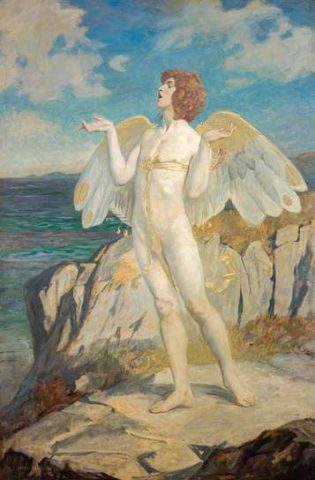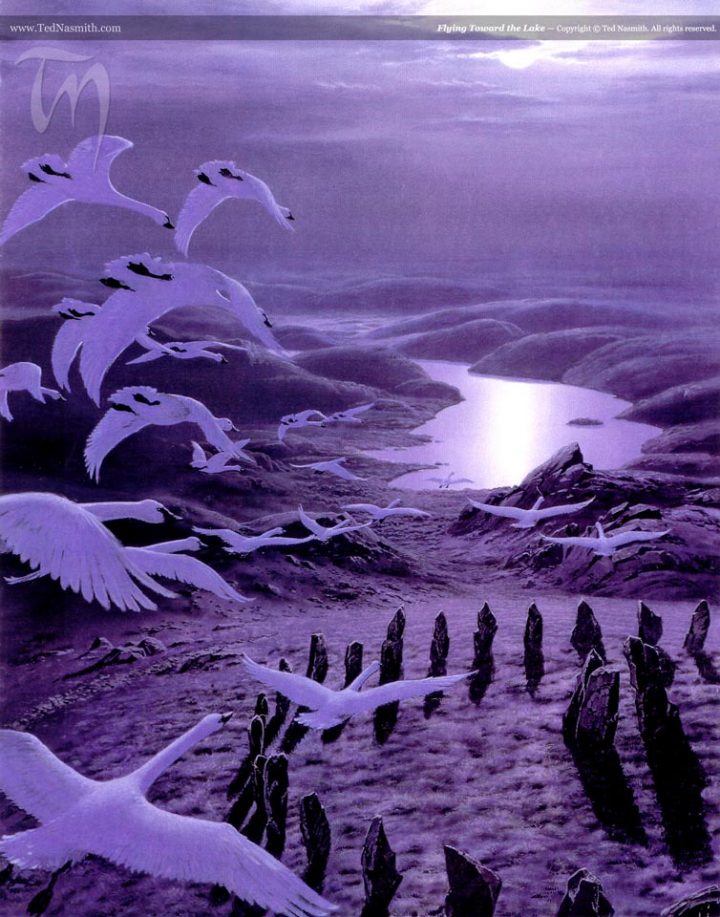Dream Angus
Nam bu leam fhin thu thaladhainn thu
Angus (il dio celtico della giovinezza)
The song of wandering Aengus
Enter Sandman
Dream Angus (Angus dei Sogni) è un personaggio leggendario nel folklore scozzese che porta bei sogni ai bambini addormentati.
E’ la versione scozzese di Sandman, un personaggio del folklore del Nord Europa, il mago sabbiolino, che porta sogni felici con la sua sabbia magica.
“Subito dalla sua nascita Angus è uno spirito gentile e sarà universalmente amato: gli uccelli canterini gli girano intorno alla testa per farlo addormentare, mentre si dondola nella culla, e il cane da caccia più selvaggio si calma quando è in sua presenza“.
Dream Angus is a legendary character in Scottish folklore that brings beautiful dreams to sleeping children, is the Scottish version of Sandman (affectionately called Sandy) a mythical character of Northern Europe folklore, the sandy wizard, who brings happy dreams sprinkling magic sand into the eyes of sleeping children.
“From the moment Angus is born it is obvious that he is a gentle spirit and will be universally loved. Songbirds circle his head to serenade him to sleep as he rocks in his cradle, and the wildest hunting dog calms when in his presence.” (from here)
Dream Angus
I
Can ye no hush your weepin’?
All the wee lambs are sleepin’
Birdies are nestlin’ nestlin’ together
Dream Angus is hirplin’ oer the heather
Chorus
Dreams to sell, fine dreams to sell
Angus is here wi’ dreams to sell
Hush my wee bairnie and sleep without fear
Dream Angus has brought you a dream my dear.
II
List’ to the curlew cryin’
Faintly the echos dyin’
Even the birdies and the beasties are sleepin’
But my bonny bairn is weepin’ weepin’
III (1)
Soon the lavrock sings his song
Welcoming the coming dawn
Lambies coorie doon the gither
Wi’ the yowies in the heather
(1) verso alternativo
Sweet the lavrock sings at morn,
Heraldin’ in a bright new dawn.
Wee lambs, they coorie doon taegether
Alang with their ewies in the heather.
Angus dei Sogni
Traduzione italiana Cattia Salto
I
Perchè non smetti di piangere?
Tutti gli agnellini sono addormentati,
gli uccellini si stanno accoccolando insieme
Angus dei Sogni si aggira per la brughiera
Coro
Sogni da vendere, bei sogni da vendere
Angus è qui con i sogni da vendere
shhh mio piccolino, dormi senza paura
Angus dei Sogni ti ha portato un sogno mio caro
II
Ascolta il chiurlo che grida
piano si smorza l’eco
anche gli uccellini e le bestie dormono
ma il mio piccolino piange, piange
III
Presto l’allodola leverà il suo canto
per salutare l’arrivo dell’alba
gli agnelli si rannicchiano assieme
con le pecorelle nell’erica
Nam bu leam fhin thu thaladhainn thu
La melodia di Dream Angus è molto simile a una ninna nanna gaelica “Nam bu leam fhin thu thaladhainn thu”, che si ritiene sia stata cantata da una fata a un bambino umano abbandonato nella foresta. Sull’isola di Skye (Isole Ebridi) è associata al clan MacLeods di Dunvegan che prendeva delle creature fatate come balia per i figli.
Christina Stewart riporta un paio di leggende associate a questo canto “In una storia alternativa, la moglie del capo dei MacLeod da alla luce un bambino, tutto per la gioia della famiglia. Tuttavia, la madre è una fata e quando il bambino è ancora piccolo, è costretta a tornare dalla sua stessa gente. Una notte, c’è una grande festa in corso nel Castello di Dunvegan e la bambinaia che doveva prendersi cura del bambino è così distratta dalla festa che lascia il bambino addormentato e va a vedere. Mentre lei è via, il bambino si sveglia e comincia a piangere. Quando lo sente, torna e trova una donna che culla il bambino, cantando questa canzone per lui.
Aveva avvolto il bambino in una coperta gialla ricamata. Mentre il bambino si calma, la donna restituisce il bambino alla balia e se ne va. La storia racconta che la donna era la madre del bambino, tornata a vedere che il suo bambino fosse al sicuro e la copertina gialla era la cosiddetta “Fairy Flag of Dunvegan”, uno stendardo che il clan avrebbe dovuto agitare nei momenti di estremo bisogno. La leggenda narra che questo vessillo ultraterreno abbia poteri miracolosi e quando dispiegato in battaglia, il clan MacLeod avrebbe invariabilmente sconfitto i loro nemici. Può essere sventolato solo 3 volte, dopo di che cadrà nella polvere.
La bandiera è stata sventolata due volte finora – nel 1480 a Blàr Bàgh na Fala e dieci anni dopo nella Battaglia di Glendale. La bandiera di per sé certamente esiste ed è un’attrazione popolare al Castello di Dunvegan. Ci sono molte storie associate ad esso e alle sue origini e questa non è l’unica ninnananna che si dice sia stata cantata dalla madre del bambino.”
Scottish gaelic
Thàladhainn, thàladhainn, thàladhainn thu
Nam bu leam fhìn thu, leanabh mo chìche
Nam bu leam fhìn thu, thàladhainn thu
Thàladhainn, thàladhainn, thàladhainn thu
The melody of Dream Angus is very similar to a Gaelic lullaby “Nam bu leam fhin thu thaladhainn thu“, which is believed to have been sung by a fairy to an abandoned human child in the forest. On the Isle of Skye (Hebrides) it is associated with MacLeods clan of Dunvegan, who took enchanted creatures as nurses for their children.
Christina Stewart reports a couple of legends associated with this song:
In an alternative story, the wife of the chief of the MacLeods gives birth to a baby, much to the joy of the family. However, the mother is a fairy woman and while the child is still a baby, she is forced to return to her own people. One night, there is a great feast going on in Dunvegan Castle and the nursemaid who is supposed to be caring for the child is so attracted by the colour and festivity that she leaves the baby sleeping and goes to watch. While she is away, the baby wakens and begins to cry. When she hears it, she comes back and finds a woman cradling the baby, singing this song to him.
She has wrapped the child in an embroidered, yellow covering. As the child calms, the woman hands the child back to the nursemaid and leaves. The story goes that the woman was the baby’s mother, returned to see that her child was kept from harm and the yellow cover was the so-called Fairy Flag of Dunvegan, a banner which the clan should wave at times of dire need. Legend has it that this otherworldly banner has miraculous powers and when unfurled in battle, the clan MacLeod would invariably defeat their enemies. It can only be waved 3 times, though, after which it will fall into dust.
The flag has been waved twice so far – in 1480 at Blàr Bàgh na Fala and ten years later at the Battle of Glendale. The flag itself certainly exists and is a popular attraction at Dunvegan Castle. There are many stories associated with it and it’s origins and this is not the only lullaby said to have been sung by the baby’s mother. (from here)
English translation:
If you were mine, I would lull you
Lull, lull, lull you
If you were mine, child of my breast
If you were mine, I would lull you
Lull, lull, lull you
traduzione italiana Cattia Salto
Se tu fossi mio, ti cullerei
cullerei, cullerei
se tu fossi mio, bimbo del mio seno
se tu fossi mio, ti cullerei
cullerei, cullerei
Angus
Nella mitologia celtica Angus (Aengus) è il dio della giovinezza, dell’ispirazione poetica e dell’amore, figlio della Ninfa Boann e del Dagda dei Tuatha Dé Danann.
In una canzone della buonanotte è chiamato “Dream Angus”, il dio dei sogni e la notte porta una sacca piena di sogni in vendita.
Sua moglie è Caer Ibormeith (Bacca di Tasso) la loro storia è l’incontro delle anime gemelle che non possono essere separate.
In the Celtic mythology Angus (Aengus) is the god of youth, of poetic inspiration and love, son of the Nymph Boann and of the Dagda of the Tuatha Dé Danann.
In a scottish goodnight song he is called “Dream Angus“, the god of dreams and by night he carries a bag full of dreams.
His wife is Caer Ibormeith and their love story is the meeting of the twin souls that can not be separated.
Angus & Caer
Secondo il mito, Angus si innamorò della fanciulla che vedeva nei suoi sogni. Ma la fanciulla era sotto un sortilegio e per poterla liberare Angus doveva riconoscerla mentre viveva nella forma di cigno. Dopo molte ricerche seppe di doverla aspettare per la festa di Samain al lago di Dragon’s Mouth (Loch Bel Dracon in italiano Bocca del Drago) dove trovò 150 cigni legati a coppie con catene d’argento.
Anime gemelle
Angus si trasformò in cigno per poter chiamare la sua Caer, così volarono insieme sorvolando il lago per tre volte, cantavano una dolce melodia che addormentò l’Irlanda per tre giorni e tre notti; ora dimorano nel Brugh Na Boinne (Newgrange)

[Aengus canta davanti al lago nella sua trasformazione in cigno]- John Duncan 1908

According to the myth, Angus fell in love with a maiden he saw in his dreams.
But she was under a spell and to be able to free her, Angus had to recognize her while she was living in the form of a swan. After much research he knew he would have to waited till Samain for going to Lake Dragon’s Mouth (Loch Bel Dracon), where he found 150 swans tied to couples with silver chains.
Twin souls
Angus turned into a swan to call Caer, so they flew together over the lake three times singing a sweet melody that fell asleep all Ireland for three days and three nights; now they live in Brugh Na Boinne (Newgrange).
The song of wandering Aengus
Yeats gli dedica al mito una poesia pubblicata nel 1899, nella raccolta di poesie “The Wind among the reeds” (Il vento fra le canne) dal titolo The song of wandering Aengus.
Il primo a mettere in musica la poesia è stato lo stesso Yeats che la compose o che vi adattò una melodia tradizionale irlandese : nel 1907 diede alle stampe il suo saggio ‘Speaking to the Psaltery’ in cui la poesia viene recitata alla maniera bardica ovvero cantata con l’accompagnamento del salterio; ma molti altri artisti furono ispirati dal testo e composero ulteriori melodie.
SCHEDA IN TERRE CELTICHE BLOG: The song of wandering Aengus (La canzone di Aengus l’errante)
Yeats dedicates a poem to him The song of wandering Aengus published in 1899, in the collection of poems “The Wind among the reeds”.
The first to put the poem into music was the same Yeats who composed or adapted a traditional Irish melody: in 1907 he published his essay ‘Speaking to the Psaltery’ in which the poem is recited bardically, sung with the accompaniment of the psaltery; but many other artists were inspired by the text and composed further melodies.
LINK
http://www.rampantscotland.com/songs/blsongs_dream.htm
http://bardmythologies.com/aengus-og/
http://www.kistodreams.org/dreamangus.asp
https://thesession.org/tunes/16464
http://www.ericdentinger.com/dream-angus_en.html
http://www.kistodreams.org/index.asp?pageid=652608
